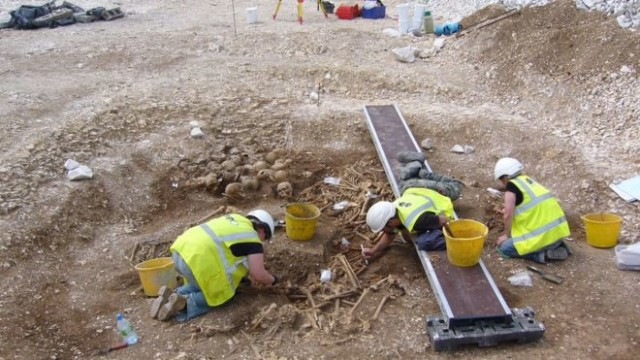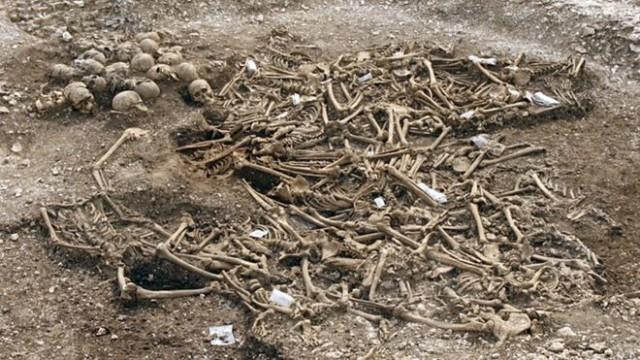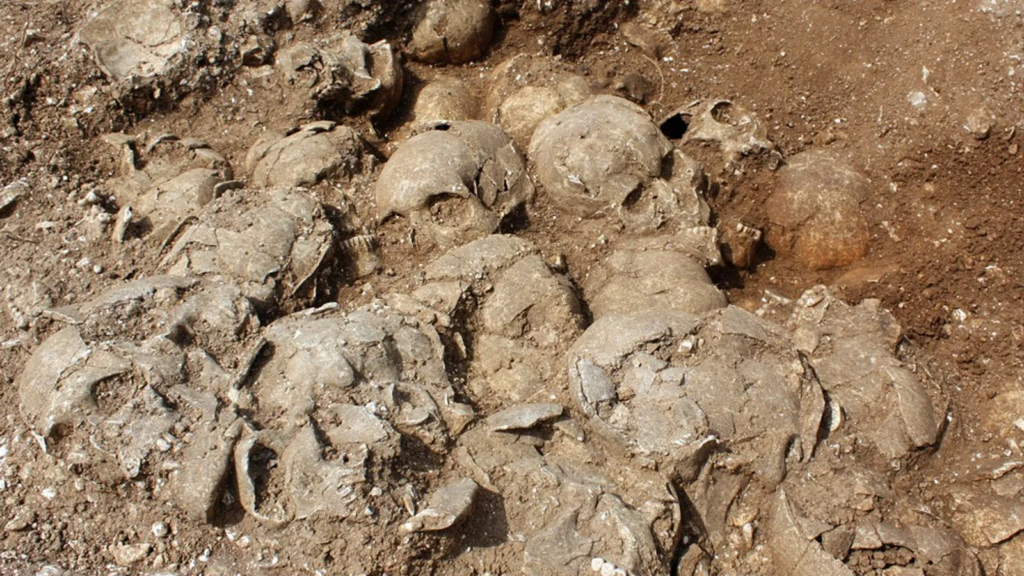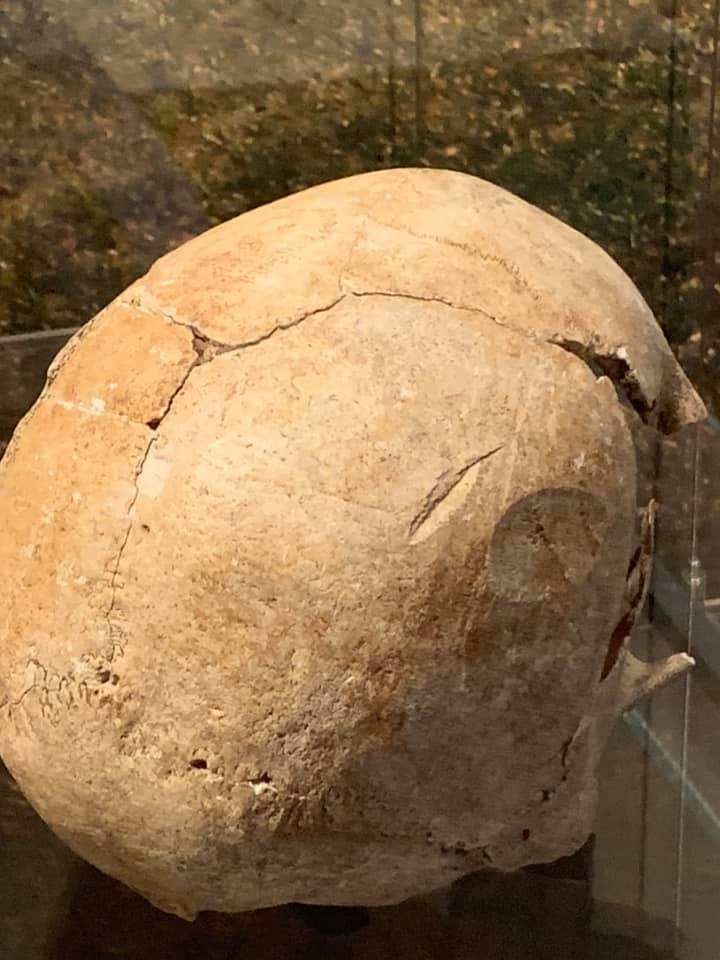
The Mass Viking Burial Pit on the South Dorset Ridgeway
In 2009, a mass Viking grave containing 54 decapitated skeletons was discovered by archaeologists on the South Dorset Ridgeway, located in the hills between Dorchester and Weymouth, England.
All of the skeletons were males, and all were buried in shallow graves with their decapitated heads piled up to one side. But what this mass burial was, or how it had come to be, was not immediately clear to archaeologists.
Carbon dating and isotype analysis conducted on the skeletons revealed to archaeologists that all of them were of Scandinavian descent and were living some time between AD 910 and AD 1030.
This is around the same time that Vikings were perpetually attacking Anglo-Saxons on the south coast of England, and the date of a very dark day in English history for Danish people, the St Brice’s Day massacre, leading to the question: were these victims of King Aethelred the Unready?
 The skull of a Viking showing a nasty end to his rampage through southern Dorset with an Anglo- Saxon sword slicing off part of his skull This can be seen in the Dorset’s County Museum, Dorchester. © RuralHistoria
The skull of a Viking showing a nasty end to his rampage through southern Dorset with an Anglo- Saxon sword slicing off part of his skull This can be seen in the Dorset’s County Museum, Dorchester. © RuralHistoria
What was the St Brice’s Day Massacre?
Aethelred the Unready was King of the English from 978 to 1013 and again from 1014 until his death in 1016. However, despite his long reign, it was not a happy one, as is suggested by his epithet, the “Unready”, meaning “badly advised”.
Aethelred’s reign was characterised by constant conflict between the English and the Danes which culminated in his ordering of the murder of all Danish men living in England in 1002. Danish raids of English territory had begun as long ago as 792 AD and continued for many years, picking up enthusiasm in the 980s and 990s.
In 991, the Battle of Maldon was won by the Vikings and Aethelred paid tribute to the Danish King. Shortly after, he married a woman of direct Danish descent, Emma of Normandy, to secure his connection to the Danes and possibly prevent further conflict.
 The Viking burial site is now part of the relief road. © RuralHistoria
The Viking burial site is now part of the relief road. © RuralHistoria
While Emma had a lasting effect on English history and helped to unite the Danes and Anglo-Saxons, the effect of her influence was not as immediate as Aethelred would have liked. The Danish raids of English land continued in earnest.
Aethelred
Finally, in 1002, Aethelred was told that the Danish posed a direct threat to his life, with plans to “faithlessly take his life, and then all his councillors, and possess his kingdom afterwards”. Hearing this, Aethelred felt matters had gone far enough.
Despite the fact that many Danish individuals had settled and intermarried with Anglo-Saxons on English land, Aethelred sought to quickly re-assert his authority over the land. And ordered the death of all Danish people living in England on the saintly feast day, 13th November, known as St Brice’s Day. The killings which ensued became known as the St Brice’s Day massacre.
It is not known whether the King’s decree reached the whole of England, as the only confirmed massacre occurred on what is now the site of St John’s College in Oxford.
 Viking Burial Pit. Oxford Archaeology said the results suggested the burial took place at the time of, or shortly after, the men’s execution which had probably been performed at the graveside.© Oxford Archaeology
Viking Burial Pit. Oxford Archaeology said the results suggested the burial took place at the time of, or shortly after, the men’s execution which had probably been performed at the graveside.© Oxford Archaeology
But massacres are now thought to have taken place in London, Bristol and Gloucester. Professor Mark Pollard, a researcher working on the Viking burial pit in Oxford, said: “Evidence of knife wounds and the burning of the bodies are consistent with the story of the burning of the church.
However, following the chemical analysis of the teeth and bones, we are presented with an alternative interpretation – that they could have been a group of professional warriors, rather than a group of residents of Danish origin, who were later rounded up and massacred.”
Similar evidence was discovered in the group of skeletons discovered in Dorset. The dating of the skeletons to around the same time as the feast-day massacre, as well as the methodical fashion of killing suggests, at least on the surface, that this event may have occurred on St Brice’s Day.
However, the alternative solution is that this may have simply been an English community’s response to one of the many raids ongoing at this time in England.
What do we know about the nature of the Dorset Viking killings?
Suggesting that it was the result of a battle or raid gone wrong. In contrast to those in the Oxford grave, all of the Dorset men were murdered methodically and beheaded from the front. The mass grave discovered in Dorset differs from the seemingly frenzied attack which occurred in Oxford. The work was undertaken by Oxford Archaeology Limited
 Wounds to necks and shoulders indicate that the process of decapitation was no less chaotic, and in some cases several blows of the sword were required to remove the heads. © Oxford Archaeology
Wounds to necks and shoulders indicate that the process of decapitation was no less chaotic, and in some cases several blows of the sword were required to remove the heads. © Oxford Archaeology
Some researchers have suggested that the skeletons may have belonged to a group of Vikings called the Jomsvikings who modelled themselves on a legendary group of mercenaries named the Jomsvikings. The Jomsvikings were a group of killers founded by Harald Bluetooth and based at Jomsborg on the Baltic coast, and were known for their strict views on battle.
Read More: Meare Heath Trackway: A Bronze Age Structure
Jawbones
The Jomsvikings, and those who sought to emulate them, valued bravery in conflict above all else, and never showed fear or ran away in battle. Due to this, some researchers have suggested that this might be one reason why the individuals were beheaded from the front, though this does not account for the unpredictable nature of battle.
Nonetheless, some of the skeletons do show evidence of defence wounds on their arms, as well as deep cuts to vertebrae, jawbones and skulls, thus pointing towards a rapid, and very unpleasant, execution.
 They had no obvious battle wounds and were most likely captives. Judging by the lack of any remains of clothing or other possessions, they had probably been naked when they were thrown into the pit. © Viking Dorset County Council
They had no obvious battle wounds and were most likely captives. Judging by the lack of any remains of clothing or other possessions, they had probably been naked when they were thrown into the pit. © Viking Dorset County Council
Such wounds may be indicative of a fight previous to the group’s surrender and eventual execution, rather than defence wounds as the researchers above suggest.
Read More: Menhirs Date From the Neolithic, But What are They?
In addition to this, many of the skeletons also showed evidence of old wounds, meaning that they were either current or previous fighters at the time of their death.
Danes
Could this point towards their recent relinquishment of the Danish cause in favour of settling peacefully among the Anglo Saxons? Perhaps. But they also have been fighters who had only recently landed in England with the aim to conquer local communities.
Another clue as to their origins and aims lies in the location of the victims bodies. The pit in which the skeletons were found does not appear to have been made specifically for the mass burial, but was rather a convenient location to dispose of their bodies.
This further supports the theory that this massacre was hastily undertaken and unplanned, though this does not disprove that they were part of the St Brice’s Day Massacres.
Who were the victims?
Isotope analysis, which uses teeth to assess an individual’s origins by assessing their enamel and dentine composition, showed that many of the men originated from somewhere in Scandinavia.
 They had not been cleanly killed, as many of them had suffered multiple blows to the vertebrae, jawbones and skulls. One Viking had his hands sliced through, suggesting that he had attempted to grab the sword as it was being swung towards him. © RuralHistoria
They had not been cleanly killed, as many of them had suffered multiple blows to the vertebrae, jawbones and skulls. One Viking had his hands sliced through, suggesting that he had attempted to grab the sword as it was being swung towards him. © RuralHistoria
Significantly, all showed evidence for a high protein diet, similar to that of individuals found on sites in Sweden. They also showed traits of being healthy and robust, suggesting good nutrition. All of the victims thus appeared to be far from home when they were executed, and of fighting age.
Read More: A Trip Along Watling Street, The Longest Roman Road in Britain
Interestingly, three skulls were missing from the 54 skeletons discovered in the pit. This lead to archaeologists to surmise that these were likely the heads of high-ranking individuals which had been taken away as souvenirs or for display on spikes. Yet no evidence of these heads has since been discovered.
Saxons
It is likely that the Dorset victims disembarked from a ship and walked inland with the aim to conquer Anglo Saxon settlements before being met by an unusually well-organised group of Saxons on a site rife with Saxon-Dane conflict.
Upon meeting other fighters, they appear to have been forced to surrender and were summarily executed.
Read More: The Largest Pre-Historic Hillforts you Should Visit
Thus, while these factors do not prove, or indeed disprove, that these individuals were victims of the St Brice’s Day Massacre. It is likely that they were executed publicly in front of a crowd as a show of authority, power and triumph.
Please follow us on Facebook and Instagram
We may never know who these men were, or how they came to be executed, but their remains may yet reveal more secrets as archaeologists continue to conduct analysis on their skeletons in the years to come.
News
The Hanging Temple: China’s 1,500-Year-Old Cliffside Marvel of Faith and Engineering
The Hanging Temple: China’s 1,500-Year-Old Cliffside Marvel of Faith and Engineering Perched precariously on the cliffs of Mount Heng in Shanxi Province, China, the Hanging Temple, also known as Xuankong Temple, Hengshan Hanging Temple, or Hanging Monastery, is an architectural…
The Willendorf Venus: A 30,000-Year-Old Masterpiece Reveals Astonishing Secrets
The Willendorf Venus: A 30,000-Year-Old Masterpiece Reveals Astonishing Secrets The “Willendorf Venus” stands as one of the most revered archaeological treasures from the Upper Paleolithic era. Discovered in 1908 by scientist Johann Veran near Willendorf, Austria, this small yet profound…
Unveiling the Maya: Hallucinogens and Rituals Beneath the Yucatán Ball Courts
Unveiling the Maya: Hallucinogens and Rituals Beneath the Yucatán Ball Courts New archaeological research has uncovered intriguing insights into the ritual practices of the ancient Maya civilization. The focus of this study is a ceremonial offering found beneath the sediment…
Uncovering the Oldest Agricultural Machine: The Threshing Sledge’s Neolithic Origins
Uncovering the Oldest Agricultural Machine: The Threshing Sledge’s Neolithic Origins The history of agricultural innovation is a fascinating journey that spans thousands of years, and one of the earliest known agricultural machines is the threshing sledge. Recently, a groundbreaking study…
Nara’s Ancient Sword: A 1,600-Year-Old Protector Against Evil Spirits
Nara’s Ancient Sword: A 1,600-Year-Old Protector Against Evil Spirits In a remarkable discovery that has captured the attention of archaeologists and historians alike, a 7.5-foot-long iron sword was unearthed from a 1,600-year-old burial mound in Nara, Japan. This oversized weapon,…
The Inflatable Plane, Dropped Behind the Lines for Downed Pilots
Experimental The Inflatable Plane, Dropped Behind the Lines for Downed Pilots The Inflatoplane from Goodyear was an unconventional aircraft developed by the Goodyear Aircraft Company, a branch of the renowned Goodyear Tire and Rubber Company, also famed for the Goodyear…
End of content
No more pages to load












